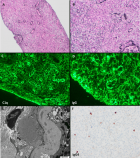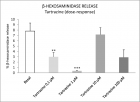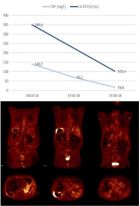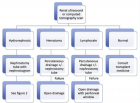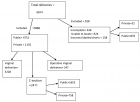Abstract
Research Article
Determine seroprevalence and associated risk factors of HBV infection among pregnant women and it relationship with blood transfusion at Hargeisa Group Hospital, Hargeisa, Somaliland
Abdullah Al-Mamari*
Published: 19 April, 2019 | Volume 3 - Issue 1 | Pages: 001-009
Background: The measures are being put in place for the management of Hepatitis B virus (HBV) infection in Hargeisa, Somaliland among pregnant women remain the most vulnerable to develop chronic hepatitis. Routine screening in pregnant women is therefore necessary for effective control. However, the performance of the commonly used the HBsAg sero test strips has been available. Also, identifying the risk factors of transmission in pregnant women is importance for the implementation of preventive measures. Hence, the goal of this study was to determining seroprevalence and associated risk factors with HBV infection among pregnant women.
Material & Methods: The study area was carried out at Hargeisa group hospital in Somaliland from May 2018 up to December 2018. The researcher was collected research pregnancy woman data through questionnaire & used diagnostics methods such as Hepatitis B surface antigen (HBsAg) test, antibodies test (HBsAb) by used anti-card test and ELIZA system. In order to find specific full information’s about patients & relationship the associated risk factors with hepatitis B in pregnancy. Data processed and analyzed by used both words and SPSS package. The sample size investigated was 80 patients. Of these, 28 were excluded; among the reasons for exclusion were prior HBV vaccination and known HBsAg sero-positive status.
Aims of Study: The study was designed & aimed to determine seroprevalence and associated factors of HBV infection among pregnant women. To assess and establish if there is significant relationship between blood transfusion and hepatitis B virus at Hargeisa group hospital (HGH).
Results and Discussion: The results in the current study shown that the pregnancy with hepatitis BV and it relation with appeared some symptoms in our study was 24(46.15%) of patients appeared they have cirrhosis symptom, 12(23.08%) of patients answered they have liver failure, while 9(17.31%) of patients appeared yellowish of eyes & skin and 5(9.62%) showed hepatic cancer.
Overall, HBV prevalence: HBsAg was detected in fifteen 15(31.3%) of the participants while all fifteen (100%) had total HBcAb (both IgM and IgG). Of the HBsAg sero-positive women, 26(42.7%) were positive for HBeAg; eight (13.3%) were positive for HBeAb and four 4(9%) were negative for both HBeAg and HBeAb which was close similar with other previous studies. On the other hand, We found identify statistically significant p-values < 0.05 and high relationship between HBV and some demographic and clinical risk factors such as blood transfusions, levels of knowledge about HBV infection in addition to age and marital status.
Conclusion: The results of this study showed that the seroprevalence of HBV infections in pregnant women and it relationship with blood transfusion in Hargeisa Group Hospital, Hargeisa, Somaliland is high. However, further studies are needed to assess the role of other demographic and clinical risk. Urgent action is required to improve hepatitis B infection control measures to reduce dependence on blood transfusions and make new policies for treatment of anemia in HGH
Read Full Article HTML DOI: 10.29328/journal.ijcv.1001003 Cite this Article Read Full Article PDF
Keywords:
Hepatitis B; Pregnant women; Blood transfusion; Risk factors; Prevalence.
References
- Aali BS. The prevalence of HBsAg among pregnant women referred to Kerman maternity hospitals in 1997. J Kerman Univ Med Sci. 1999; 6: 89–96. Ref.: https://tinyurl.com/y4ogz42d
- Abram SB. Control of Communicable diseases Manual. 16th ed. Am Public Health Assoc. 1995: 250-252.
- Allain JP1, Candotti D, Soldan K, Sarkodie F, Phelps B, et.al. The risk of hepatitis B virus infection by transfusion in Kumasi, Ghana. Blood. 2003; 101: 2419-2425. Ref.: https://tinyurl.com/y36of2fg
- Al Awaidy S, Abu-Elyazeed R, Al Hosani H, Al Mulla A, Al Busaiedy S, et.al. Sero-epidemiology of hepatitis B infection in pregnant women in Oman, Qatar and the United Arab Emirates. J Infect. 2006; 52: 202–206. Ref.: https://tinyurl.com/y3csusue
- Alter MJ, Hadler SC, Judson FN, Mares A, Alexander WJ, et.al. Risk factors for acute non-A, non-B hepatitis in the United States and association with hepatitis C virus infection. JAMA. 1990; 264: 2231–2235. Ref.: https://tinyurl.com/y29bzo5c
- Aweis D, Brabin BJ, Beeching NJ, Bunn JE, Cooper C, et al. Hepatitis B prevalence and risk factors for HBsAg carriage amongst Somali households in Liverpool. Commun Dis Public Health. 2001; 4: 247-252. Ref.: https://tinyurl.com/y5wj7zck
- Awole M, Gebre-Selassie S. Seroprevalence of HbsAg and its risk factors among pregnant women in Jimma, Southwest Ethiopia. Ethiop J Health Dev. 2005; 19: 45-51. Ref.: https://tinyurl.com/yyphoe4s
- Bile K, Mohamud O, Aden C, Isse A, Norder H, et.al. The risk for hepatitis A, B, and C at two institutions for children in Somalia with different socioeconomic conditions. Am J Trop Med Hyg. 1992; 47: 357-364. Ref.: https://tinyurl.com/y2hz62hj
- Beasley PR. Hepatitis B virus as the etiologic agent in hepatocellular carcinoma, epidemiologic considerations. Hepatology 1982; (Suppl): 21S–6S. Ref.: https://tinyurl.com/y2d6eqd7
- Euler GL, Wooten KG, Baughman AL, Williams WW. Hepatitis B surface antigen prevalence among pregnant women in urban areas: implications for testing, reporting, and preventing perinatal transmission. Pediatrics. 2003; 111(Suppl1): 1192–1197. Ref.: https://tinyurl.com/y2jmjcrc
- Jaffari RM, Saadati N, Esfarjani SH, Cheshmeh AS. A survey of the frequency of HBsAg+status in pregnant women attending health centers in Ahwaz. Payesh. 2004; 3: 237–243. Ref.: https://tinyurl.com/yxoprd8g
- Jatau ED, Yabaya A. Seroprevalence of Hepatitis B virus in pregnant women attending a clinic in Zaria, Nigeria. Sci World J. 2004;4(2):7-9. Kitchen A. Hepatitis B and blood safety. Vaccine. 1998; 16: S34–S37. Ref.: https://tinyurl.com/y2xyy6zl
- Lewis-Ximenez LL, do OK, Ginuino, CF, Silva JC, Schatzmayr HG, et.al. Risk factors for hepatitis B virus infection in Rio de Janeiro, Brazil. BMC Public Health. 2002; 2: 26. Ref.: https://tinyurl.com/y6zpfjq4
- Makuwa M, Caron M, Souquière S, Malonga-Mouelet G, Mahé A, et al. Prevalence and genetic diversity of hepatitis B and delta viruses in pregnant women in Gabon: molecular evidence that hepatitis delta virus clade 8 originates from and is endemic in central Africa. J Clin Microbiol. 2008; 46: 754–756. Ref.: https://tinyurl.com/y2nj7qr9
- Mirghaforvand M, Montazam SH, Rafie A. Study of prevalence and contributing factors of hepatitis B among pregnant women referred to laboratory of health center of Bonab. J Urmia Nurs Midwifery Fac. 2007; 5: 120–131. Ref.: https://tinyurl.com/yyg6zxcs
- Moestrup T, Hansson BG, Widell A, Nordenfelt E, Hägerstrand I. Long term follow up of chronic hepatitis B virus infection in intravenous drug abusers and homosexual men. Br Med J. 1986; 292: 854–857. Ref.: https://tinyurl.com/y38pcge3
- Jonas MM. Hepatitis B and Pregnancy: An Underestimated Issue. Liv Int. 2009; 29(suppl1): 133-139. Ref.: https://tinyurl.com/y2zgxlvp
- Okoth F, Mbuthia J, Gatheru Z, Murila F, Kanyingi F, et al. Seroprevalence of hepatitis B markers in pregnant women in Kenya. East Afr Med J. 2009; 83: 485–493. Ref.: https://tinyurl.com/y4t2xt5c
- Okonko IO, Udeze AO. Detection of Hepatitis B surface antigen (HBsAg) among pregnant women attending Antenatal Clinic at OLA Catholic Hospital, Oluyoro, Ibadan, Oyo State, Southwestern Nigeria. Nat Sci. 2011; 9: 54-60. Ref.: https://tinyurl.com/y3qlzukr
- Phoon WO, Fong NP, Lee J. History of blood transfusion, tattooing, acupuncture and risk of hepatitis B surface antigenaemia mong Chinese men in Singapore. Am J Public Health. 1988; 78: 958-960. Ref.: https://tinyurl.com/y62v4jjw
- Rabiu KA, Akinola OI, Adewunmi AA, Omololu OM, Ojo TO. Risk factors for hepatitis B virus infection among pregnant women in Lagos, Nigeria. Acta Obstet Gynecol Scand. 2010; 89: 1024–1028. Ref.: https://tinyurl.com/y6mppcmy
- Reynolds L, McKee M. Possible risks of transmission of blood borne infection via acupuncture needles in Guizhou province, southwest China. J Altern Complement Med. 2008; 14: 1281-1285. Ref.: https://tinyurl.com/y4aclylc
- Sharma R, Sharma CL, Khajuria R. The knowledge, attitude and practices regarding HBV infection of married women in the reproductive Age group living in cantonment Area Sunjawan Jammu. J Med Educ Res. 2004; 6: 127–130. Ref.: https://tinyurl.com/y4zumt9y
- Tran TT. Management of hepatitis B in pregnancy weighing the options. Cleve. Clin J Med. 2009; 76(Suppl 3): S25–S29. Ref.: https://tinyurl.com/yydg4c5u
- Waheed Y, Rahat T, Safi B, Qadri I. Epidemiological patterns and risk factors associated with hepatitis B virus in Pakistani population. Asian Biomedicine. 2010; 4: 547-551. Ref.: https://tinyurl.com/y5appl6l
Figures:

Figure 1

Figure 2

Figure 3
Similar Articles
-
Determine seroprevalence and associated risk factors of HBV infection among pregnant women and it relationship with blood transfusion at Hargeisa Group Hospital, Hargeisa, SomalilandAbdullah Al-Mamari*. Determine seroprevalence and associated risk factors of HBV infection among pregnant women and it relationship with blood transfusion at Hargeisa Group Hospital, Hargeisa, Somaliland. . 2019 doi: 10.29328/journal.ijcv.1001003; 3: 001-009
-
The Psychology of the Common Cold and Influenza: Implications for COVID-19Andrew P Smith*. The Psychology of the Common Cold and Influenza: Implications for COVID-19. . 2020 doi: 10.29328/journal.ijcv.1001011; 4: 027-031
-
Serological and virological profile of patients with chronic hepatitis B infection in EritreaMohammed Elfatih Hamida*,Saud Mohammed Raja,Yemane Seyoum,Isam Mohammed Elkhidir,Freweini Tekle. Serological and virological profile of patients with chronic hepatitis B infection in Eritrea. . 2020 doi: 10.29328/journal.ijcv.1001022; 4: 096-101
-
Lipid profile of antiretroviral therapy-naive HIV-infected patients attending infectious diseases service of University Teaching Hospital of Kinshasa, Democratic Republic of the Congo (DRC)MMK Mbula*,HNT Situakibanza,GL Mananga,B Longo Mbenza,JRR Makulo,MM Longokolo,MN Mandina,NN Mayasi,MM Mbula,B Bepouka,GL Mvumbi,BT Buasa,EN Amaela,DN Tshilumba,O Odio,A Nkodila. Lipid profile of antiretroviral therapy-naive HIV-infected patients attending infectious diseases service of University Teaching Hospital of Kinshasa, Democratic Republic of the Congo (DRC). . 2020 doi: 10.29328/journal.ijcv.1001023; 4: 102-108
-
Contemplating SARS-CoV-2 infectivity with respect to ABO blood groupsQurat-ul-Ain Amjad,Umar Saeed*,Zahra Zahid Piracha,Kashmala Kanwal,Madiha Munir,Atika Waseem,Tayyaba Nisar,Arisha Shoukat,Rizwan Uppal. Contemplating SARS-CoV-2 infectivity with respect to ABO blood groups. . 2021 doi: 10.29328/journal.ijcv.1001039; 5: 082-086
-
Clinical and biological profiles of older adults aged 50 and over compared to those under 50 in people living with HIV attending Kinshasa University Teaching Hospital (DR Congo)MMK Mbula*,B Longo-Mbenza,HNT Situakibanza,GL Mananga,JRR Makulo,MM Longokolo,MN Mandina,NN Mayasi,MM Mbula,B Bepouka,GL Mvumbi,EN Amaela,DN Tshilumba,O Odio,BM Ekila,A Nkodila,T Pindi,BBT Buasa. Clinical and biological profiles of older adults aged 50 and over compared to those under 50 in people living with HIV attending Kinshasa University Teaching Hospital (DR Congo). . 2021 doi: 10.29328/journal.ijcv.1001040; 5: 087-095
-
Mass Serological Screening in the Armed Forces Using the Serum-Pooling Method. Analytical Evaluation of the Chemiluminescence MethodAbi R*,Ameur O,Hassine S,Chanhih N,Ouannass S,Goura H,Eddaif KH,Elkochri S,Aadi Y,Elbenaissi Y,Tagajdid MR,Elannaz H,Laraqui A,Elmchichi B,Touil N,Kasouati J,Elouennass M,Ennibi K,Lahlou IA. Mass Serological Screening in the Armed Forces Using the Serum-Pooling Method. Analytical Evaluation of the Chemiluminescence Method. . 2025 doi: 10.29328/journal.ijcv.1001062; 9: 001-004
Recently Viewed
-
Cystoid Macular Oedema Secondary to Bimatoprost in a Patient with Primary Open Angle GlaucomaKonstantinos Kyratzoglou*,Katie Morton. Cystoid Macular Oedema Secondary to Bimatoprost in a Patient with Primary Open Angle Glaucoma. Int J Clin Exp Ophthalmol. 2025: doi: 10.29328/journal.ijceo.1001059; 9: 001-003
-
Metastatic Brain Melanoma: A Rare Case with Review of LiteratureNeha Singh,Gaurav Raj,Akshay Kumar,Deepak Kumar Singh,Shivansh Dixit,Kaustubh Gupta*. Metastatic Brain Melanoma: A Rare Case with Review of Literature. J Radiol Oncol. 2025: doi: ; 9: 050-053
-
Depression as a civilization-deformed adaptation and defence mechanismBohdan Wasilewski*,Olha Yourtsenyuk,Eugene Egan. Depression as a civilization-deformed adaptation and defence mechanism. Insights Depress Anxiety. 2020: doi: 10.29328/journal.ida.1001013; 4: 008-011
-
Drinking-water Quality Assessment in Selective Schools from the Mount LebanonWalaa Diab, Mona Farhat, Marwa Rammal, Chaden Moussa Haidar*, Ali Yaacoub, Alaa Hamzeh. Drinking-water Quality Assessment in Selective Schools from the Mount Lebanon. Ann Civil Environ Eng. 2024: doi: 10.29328/journal.acee.1001061; 8: 018-024
-
Rapid Microbial Growth in Reusable Drinking Water BottlesQishan Liu*,Hongjun Liu. Rapid Microbial Growth in Reusable Drinking Water Bottles. Ann Civil Environ Eng. 2017: doi: 10.29328/journal.acee.1001007; 1: 055-062
Most Viewed
-
Evaluation of Biostimulants Based on Recovered Protein Hydrolysates from Animal By-products as Plant Growth EnhancersH Pérez-Aguilar*, M Lacruz-Asaro, F Arán-Ais. Evaluation of Biostimulants Based on Recovered Protein Hydrolysates from Animal By-products as Plant Growth Enhancers. J Plant Sci Phytopathol. 2023 doi: 10.29328/journal.jpsp.1001104; 7: 042-047
-
Sinonasal Myxoma Extending into the Orbit in a 4-Year Old: A Case PresentationJulian A Purrinos*, Ramzi Younis. Sinonasal Myxoma Extending into the Orbit in a 4-Year Old: A Case Presentation. Arch Case Rep. 2024 doi: 10.29328/journal.acr.1001099; 8: 075-077
-
Feasibility study of magnetic sensing for detecting single-neuron action potentialsDenis Tonini,Kai Wu,Renata Saha,Jian-Ping Wang*. Feasibility study of magnetic sensing for detecting single-neuron action potentials. Ann Biomed Sci Eng. 2022 doi: 10.29328/journal.abse.1001018; 6: 019-029
-
Pediatric Dysgerminoma: Unveiling a Rare Ovarian TumorFaten Limaiem*, Khalil Saffar, Ahmed Halouani. Pediatric Dysgerminoma: Unveiling a Rare Ovarian Tumor. Arch Case Rep. 2024 doi: 10.29328/journal.acr.1001087; 8: 010-013
-
Physical activity can change the physiological and psychological circumstances during COVID-19 pandemic: A narrative reviewKhashayar Maroufi*. Physical activity can change the physiological and psychological circumstances during COVID-19 pandemic: A narrative review. J Sports Med Ther. 2021 doi: 10.29328/journal.jsmt.1001051; 6: 001-007

HSPI: We're glad you're here. Please click "create a new Query" if you are a new visitor to our website and need further information from us.
If you are already a member of our network and need to keep track of any developments regarding a question you have already submitted, click "take me to my Query."






